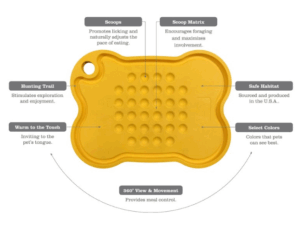The Science Behind Why Dogs Love to Lick—And Why It’s Good for Both of You
Ever wonder why your dog loves to lick your hands, face, or even their favorite enrichment toy? While it might seem like a quirky behavior, licking is much more than a cute canine habit—it’s rooted in biology, emotional bonding, and even stress relief.
In fact, research shows that licking triggers the release of endorphins in dogs, helps lower their stress hormone cortisol, and can strengthen the bond between you and your pet. Here’s why that matters—and how you can use licking as part of a healthy enrichment routine.
Licking Releases Endorphins in Dogs
Endorphins are “feel-good” chemicals produced by the brain, and studies have shown that repetitive actions like licking can release these natural opioids in dogs. These endorphins help calm anxiety, reduce pain, and create a sense of pleasure or comfort.
According to veterinary behaviorist Dr. Bonnie Beaver, licking can become a self-soothing behavior that helps dogs manage stress, much like how humans might fidget or doodle when nervous. A study published in the Journal of Veterinary Behavior noted that repetitive behaviors like licking can activate the brain’s opioid system, leading to increased relaxation in dogs under stress.1
Licking Lowers Cortisol (the Stress Hormone)
In addition to releasing endorphins, licking is shown to reduce levels of cortisol, the hormone associated with stress and anxiety. Feeding with enrichment toys has been found to decrease cortisol levels.2
When your dog is licking a food-filled enrichment toy (like a Pet Platter or Kong), they’re not just enjoying the taste—they’re experiencing a calming, soothing effect. This is especially beneficial for dogs who deal with separation anxiety or noise phobias.
Research from Applied Animal Behaviour Science found that dogs engaged in licking and foraging behaviors had significantly lower cortisol levels after enrichment activities compared to baseline measurements.3

Enrichment Tools That Encourage Healthy Licking
Here are a few safe, fun ways to provide your dog with licking-based enrichment:
- Mine Pet Platter / Lick Mats: Spread with plain yogurt, pumpkin, or peanut butter (xylitol-free!)
- Frozen Kongs / Woof Balls: Fill with wet food or mashed banana and freeze for a longer experience
- Snuffle mats: Great for combining licking and nose work
- Kong Wobbler – an action-packed toy that is a mentally stimulating food dispenser.
Pro Tip: Use licking enrichment before or during a stressful event—like car rides, vet visits, or thunderstorms—to naturally help soothe your pup.
Why It Matters
At Innovative Pet Lab, we understand that gut health, mental health, and behavior are all connected (Gut-Brain Axis). Enrichment activities like licking are one simple way to support your dog’s emotional wellness, alongside diet, movement, and proactive health testing.
When your dog licks, it’s not just about taste—it’s about calming their mind, soothing their body, and strengthening your bond.
Want to Learn More About Your Pet’s Internal Health?
Excessive licking can be a sign of various issues, such as anxiety & stress, inflammatory bowel disease (IBD) or food allergies. If the licking is excessive —especially paws, floors, or walls, or accompanied by other symptoms like vomiting, diarrhea, weight loss, or changes in appetite it may be time to seek veterinary support.
Our Gut Health Test helps you uncover:
- Gut lining strength
- Gut inflammation
- Digestive enzyme imbalance
- Absorption issues
Knowledge is power—and peace of mind.
Order Your Test HERE
References:
- Beaver, B. V. (2001). Canine Behavior: Insights and Answers. Saunders.
LINK - Safinaz A. Ibrahim, et. al. (2020) Springing Bottles Enrichment Toy Effect on Behaviors and Cortisol Level of Kenneled Dogs (Canis lupus familiaris) Alexandria Journal of Veterinary Sciences 66(2):20-29. LINK
- Horváth, Zs., Dóka, A., Miklósi, Á. (2008). Affiliative and disciplinary behavior of human handlers during play with their dog affects cortisol concentrations in opposite directions. Hormones and Behavior, 54(1), 107–114.
LINK